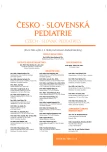Extreme hypokalaemia in familial periodic paralysis – case report
Authors:
I. Pospíšilová 1,3; D. Šišková 2; M. Bloomfield 3,4; R. Vyhnánek 3; L. Fajkusová 5; J. Zídková 5; M. Magner 3,6; K. Bořecká 1
Authors‘ workplace:
Oddělení klinické biochemie, Thomayerova nemocnice, Praha
1; Oddělení dětské neurologie, Thomayerova nemocnice, Praha
2; Pediatrická klinika 1. LF UK a Thomayerovy nemocnice, Praha
3; Ústav imunologie 2. LF UK a FN Motol, Praha
4; Centrum molekulární biologie a genové terapie IHOK, FN Brno
5; Klinika pediatrie a dědičných poruch metabolismu 1. LF UK a VFN, Praha
6
Published in:
Čes-slov Pediat 2020; 75 (6): 337-341.
Category:
Overview
Periodic paralysis (PP) is a rare neuromuscular disorder characterized by episodic muscle weakness with abnormal levels of potassium in the blood.
We present a case report of a 17-year-old boy with a familial form of hypokalaemic periodic paralysis. The disease manifested as caudocranially progressive symmetrical muscle weakness of the limbs with rapid onset in the early morning hours shortly after awakening. Three days prior, the boy had noticed increased tiredness of the lower limbs. His past medical history was unremarkable. Extremely low potassium was observed in the laboratory (1.1 mmol/l; normal 3.3–4.7 mmol/l) with concomitant marked hypophosphatemia (0.43 mmol/l; normal 0.94–1.55 mmol/l), normal magnesaemia (0.80 mmol/l; normal 0.62–0.91 mmol/l), normal natremia and chloridaemia (Na 139 mmol/l; Cl 108 mmol/l). The parameters of the acid-base balance were undisturbed. The markers of muscle metabolism (creatine kinase and transaminases) were normal, myoglobin was slightly increased. With the therapeutically achieved normalization of potassium, the above-mentioned clinical symptoms resolved within three hours.
Upon exclusion of the secondary causes of hypokalaemia (especially thyrotoxicosis and renal tubular disorders) the diagnosis of hypokalaemic periodic paralysis was suspected. Molecular genetic testing detected a heterozygous point mutation in SCN4A gene located on chromosome 17 (17q23), encoding the alpha-subunit of the sodium channel, thus confirming the diagnosis of familial hypokalemic periodic paralysis of type 2. The identical pathogenic variant was found in the asymptomatic father of the patient.
Conclusion: The diagnosis of primary PP is based on the characteristic clinical presentation and confirmed by genetic testing. The absence of previous spontaneously receding episodes of muscle weakness in the family or personal history does not exclude the primary (familial) form of PP.
Keywords:
hypokalaemia – muscle weakness – periodic paralysis
Sources
1. Statland JM, Fontaine B, Hanna MG, et al. Review of the diagnosis and treatment of periodic paralysis. Muscle Nerve 2018; 57 (4): 522–530.
2. Jabor A, et al. Vnitřní prostředí. 1. vyd. Praha: Grada Publishing, a. s., 2008 : 432–435.
3. Weber F, Lehmann-Horn F. Hypokalemic periodic paralysis. 2002 Apr 30 [Updated 2018 Jul 26]. In: Adam MP, Ardinger HH, Pagon RA, et. al. (eds). Gene Reviews® [Internet]. Seattle (WA): Univerzity of Washington, 1993–2020.
4. Lin SH, Huang CL. Mechanism of thyreotoxic periodic paralysis. J Am Soc Nephrol 2012; 23 (6): 985–988.
5. Park S, Kim TY, Sim S, et al. Association of KCNJ2 genetic variants with susceptibility to thyreotoxic periodic paralysis in patients with Grawes‘ disease. Exp Clin Endocrinol Diabetes 2017; 125 (2): 75–78.
6. Lam L, Nair RJ, Tingle L. Thyreotoxic periodic paralysis. Proc (Bayl Univ Med Cent), 2006 Apr; 19 (2): 126–129.
7. Kardalas E, Paschou SA, Anagnostis P, et al. Hypokalemia: a clinical update. Endocr Connect 2018,7: R135–146.
8. Doležal Z, Novotná D, Schneiderová H, et al. Tyreotoxická periodická paralýza. Pediatr praxi 2016; 17 (6): 379–382.
9. Srivastava RN, Bagga A. Pediatric Nefrology. 5th ed. India: Yaypee Brothers Medical Publishers (P) Ltd., 2011 : 101–105.
10. Kliegman RM, Stanton BF, Geme JW, et al. Nelson Textbook of Pediatrics. 19th ed. Philadelphia: Elsevier Saunders, 2011 : 224.
Labels
Neonatology Paediatrics General practitioner for children and adolescentsArticle was published in
Czech-Slovak Pediatrics

2020 Issue 6
- What Effect Can Be Expected from Limosilactobacillus reuteri in Mucositis and Peri-Implantitis?
- The Importance of Limosilactobacillus reuteri in Administration to Diabetics with Gingivitis
Most read in this issue
- Extreme hypokalaemia in familial periodic paralysis – case report
- Ascaris: a rare cause of nighttime abdominal pain in children – case report
- Brain abscess in children – overview and two case reports
- Vasculitis as a rare manifestation of Sarcoptes scabiei infestation – case report
